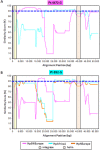Genomic structure and insertion sites of Helicobacter pylori prophages from various geographical origins
- PMID: 28205536
- PMCID: PMC5311958
- DOI: 10.1038/srep42471
Genomic structure and insertion sites of Helicobacter pylori prophages from various geographical origins
Abstract
Helicobacter pylori genetic diversity is known to be influenced by mobile genomic elements. Here we focused on prophages, the least characterized mobile elements of H. pylori. We present the full genomic sequences, insertion sites and phylogenetic analysis of 28 prophages found in H. pylori isolates from patients of distinct disease types, ranging from gastritis to gastric cancer, and geographic origins, covering most continents. The genome sizes of these prophages range from 22.6-33.0 Kbp, consisting of 27-39 open reading frames. A 36.6% GC was found in prophages in contrast to 39% in H. pylori genome. Remarkably a conserved integration site was found in over 50% of the cases. Nearly 40% of the prophages harbored insertion sequences (IS) previously described in H. pylori. Tandem repeats were frequently found in the intergenic region between the prophage at the 3' end and the bacterial gene. Furthermore, prophage genomes present a robust phylogeographic pattern, revealing four distinct clusters: one African, one Asian and two European prophage populations. Evidence of recombination was detected within the genome of some prophages, resulting in genome mosaics composed by different populations, which may yield additional H. pylori phenotypes.
Conflict of interest statement
The authors declare no competing financial interests.
Figures



Similar articles
-
Gene content, phage cycle regulation model and prophage inactivation disclosed by prophage genomics in the Helicobacter pylori Genome Project.Gut Microbes. 2024 Jan-Dec;16(1):2379440. doi: 10.1080/19490976.2024.2379440. Epub 2024 Aug 12. Gut Microbes. 2024. PMID: 39132840 Free PMC article.
-
Screening of KHP30-like prophages among Japanese Helicobacter pylori strains, and genetic analysis of a defective KHP30-like prophage sequence integrated in the genome of the H. pylori strain NY40.FEMS Microbiol Lett. 2016 Aug;363(16):fnw157. doi: 10.1093/femsle/fnw157. Epub 2016 Jul 7. FEMS Microbiol Lett. 2016. PMID: 27388014
-
Comparative genomics of a Helicobacter pylori isolate from a Chinese Yunnan Naxi ethnic aborigine suggests high genetic divergence and phage insertion.PLoS One. 2015 Mar 23;10(3):e0120659. doi: 10.1371/journal.pone.0120659. eCollection 2015. PLoS One. 2015. PMID: 25799515 Free PMC article.
-
Relating Phage Genomes to Helicobacter pylori Population Structure: General Steps Using Whole-Genome Sequencing Data.Int J Mol Sci. 2018 Jun 21;19(7):1831. doi: 10.3390/ijms19071831. Int J Mol Sci. 2018. PMID: 29933614 Free PMC article. Review.
-
The Story of Helicobacter pylori: Depicting Human Migrations from the Phylogeography.Adv Exp Med Biol. 2019;1149:1-16. doi: 10.1007/5584_2019_356. Adv Exp Med Biol. 2019. PMID: 31016625 Review.
Cited by
-
Comparative genomics of Lactobacillaceae from the gut of honey bees, Apis mellifera, from the Eastern United States.G3 (Bethesda). 2022 Dec 1;12(12):jkac286. doi: 10.1093/g3journal/jkac286. G3 (Bethesda). 2022. PMID: 36331337 Free PMC article.
-
Cryptic Prophages Contribution for Campylobacter jejuni and Campylobacter coli Introgression.Microorganisms. 2022 Feb 26;10(3):516. doi: 10.3390/microorganisms10030516. Microorganisms. 2022. PMID: 35336092 Free PMC article.
-
Bacteriophages of Helicobacter pylori.Front Microbiol. 2020 Nov 12;11:549084. doi: 10.3389/fmicb.2020.549084. eCollection 2020. Front Microbiol. 2020. PMID: 33281754 Free PMC article. Review.
-
Prophage dynamics in gastric and enterohepatic environments: unraveling ecological barriers and adaptive transitions.ISME Commun. 2025 Feb 4;5(1):ycaf017. doi: 10.1093/ismeco/ycaf017. eCollection 2025 Jan. ISME Commun. 2025. PMID: 39981300 Free PMC article.
-
Genome-Wide Identification and Analysis of Chromosomally Integrated Putative Prophages Associated with Clinical Klebsiella pneumoniae Strains.Curr Microbiol. 2021 May;78(5):2015-2024. doi: 10.1007/s00284-021-02472-2. Epub 2021 Apr 3. Curr Microbiol. 2021. PMID: 33813641
References
Publication types
MeSH terms
Grants and funding
LinkOut - more resources
Full Text Sources
Other Literature Sources
Miscellaneous

